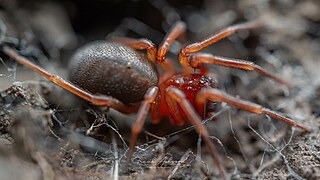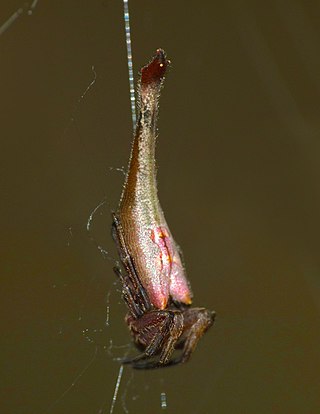
Sidymella rubrosignata is a species of crab spiders found in Australia. It is a common spider, often seen on Dianella plants.
Zealanapis australis is a spider species in the genus Zealanapis found in New Zealand.

Trite auricoma, commonly known as the golden-brown jumping spider, is a species of jumping spider endemic to New Zealand.

Sidymella is a genus of spider in the family Thomisidae, found in South America, Australia and New Zealand. It was originally named Sidyma, but this was later found to have been used already for a genus of moths.

Poaka is a genus of intertidal spiders containing the single species, Poaka graminicola endemic to New Zealand.

Colaranea melanoviridis is a species of orb-weaver spider that is endemic to New Zealand.

Periegops suterii is a species of spider in the genus Periegops that is endemic to the South Island of New Zealand.

Diaea ambara is a species of crab spider that is endemic to New Zealand.

Acroaspis decorosa is a species of orbweaver spider that is endemic to New Zealand.

Arachnura feredayi, the tailed forest spider or scorpion-tailed spider, is endemic to New Zealand. It is known for the distinctive tapering body shape in females, which are also much larger than males, and for producing vertical columns of egg sacs in their webs.
Cantuaria depressa is a species of trapdoor spider endemic to New Zealand.
Cantuaria pilama is a species of trapdoor spider endemic to New Zealand.
Hexathele waipa is a species of mygalomorph spider endemic to New Zealand.

Cryptaranea albolineata is a species of orb-weaver spider that is endemic to New Zealand.
Haplinis fucatinia is a species of sheet weaver spider endemic to New Zealand.
Haplinis mundenia is a species of sheet weaver spider endemic to New Zealand.
Haplinis rufocephala is a species of sheet weaver spider endemic to New Zealand.
Nomaua nelson is a species of Physoglenidae spider endemic to New Zealand.
Clubiona blesti is a species of Clubionidae spider endemic to New Zealand.
Pakeha subtecta is a species of Cycloctenidae spider that is endemic to New Zealand.














